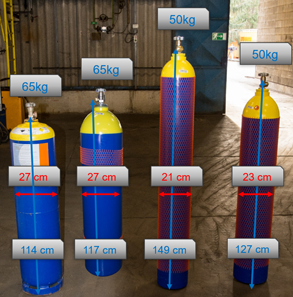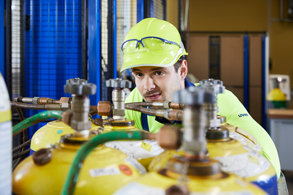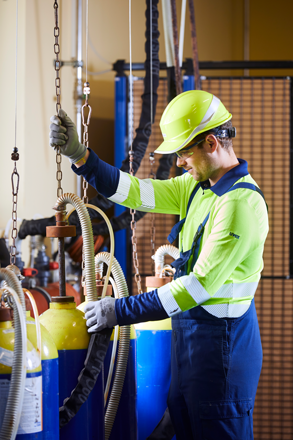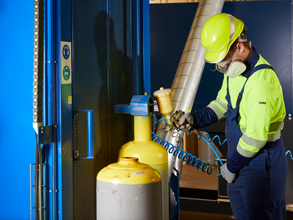Chlorine gas is the most widely used water treatment agent in the world due to its ability to disinfect water within minutes. At Donau Chemie, we ensure that this potentially toxic gas is handled properly by not only performing thorough checks every time it is filled, but also by offering TÜV testing as an additional safety service for our customers.
Chlorine gas: effective hygiene measures and their potential risks
Chlorine gas is an extremely effective disinfectant which is used, among other things, in bathing water treatment (public indoor and outdoor pools, spas, hotels) as well as in wastewater and drinking water treatment. The addition of chlorine eliminates harmful microorganisms such as bacteria, viruses and fungi, preventing the spread of disease through the water.
However, the desired effectiveness of chlorine gas goes hand in hand with potential risks:
-
Reactivity: chlorine gas reacts readily with other substances, especially flammable materials, and can form explosive mixtures.
-
Corrosivity: Since chlorine gas is soluble in water, it reacts with the humidity of the air to form hydrochloric acid, which causes severe corrosion
-
Acute toxicity: Chlorine gas can cause severe health problems, including respiratory problems, nausea, and eye and skin irritation.
Handling chlorine gas therefore requires special training and strict safety precautions to minimize risks. This includes testing during filling, regular TÜV inspections, and training in the handling of chlorine gas.
Safety first: inspections during chlorine gas filling
Chlorine gas is supplied to bulk customers in TÜV-approved chlorine gas cylinders or chlorine drums, always assuming that they have the necessary official poison supply certificate. Customers who already own chlorine gas cylinders have the option of having them filled and tested by us.
 Chlorine gas cylinders are delivered in steel gas containers with different weight contents (50 kg and 65 kg), chlorine gas drums in container sizes of 500 kg and 1,000 kg. In addition, special containers such as laboratory cylinders (5-12 kg), returnable containers and emergency sets for cylinders and drums are available.
Chlorine gas cylinders are delivered in steel gas containers with different weight contents (50 kg and 65 kg), chlorine gas drums in container sizes of 500 kg and 1,000 kg. In addition, special containers such as laboratory cylinders (5-12 kg), returnable containers and emergency sets for cylinders and drums are available.
Regardless of whether they are our own containers or those of our customers, all containers undergo a comprehensive safety inspection before filling and delivery.
This test includes the following steps:
-
Leak test: the tightness is tested by means of ammonia, since ammonia reacts with chlorine gas in the event of a leak, resulting in a visible reaction in the form of mist.
-
Valve inspection: the valve is checked for free movement and other abnormalities to ensure that it functions properly and can be opened and closed easily.
-
Visual inspection: the outer surface is visually inspected to detect possible damage such as cracks, dents, corrosion or other abnormalities.
TÜV inspection: New service for our customers

Chlorine gas cylinders and drums must be tested by TÜV every 5 years to ensure that they meet the required safety standards. However, it is proving difficult to find qualified companies that are certified to carry out these tests.
For this reason, we have been offering our customers the option of TÜV testing as part of our safety service since 2023. The inspection is carried out under the supervision of TÜV at our plant in Brückl. In addition, we organize comprehensive training directly at the customer's site to ensure the safe handling of chlorine gas containers.
The steps of the TÜV inspection for chlorine gas cylinders and drums in detail:
-
Degassing: the chlorine gas remaining in the chlorine gas cylinder is returned to production via a circuit that is closed off from the environment, so that it can be reused.
-
 Valve removal: the valve on the chlorine gas cylinder is removed to allow a thorough check but also an inspection of the inside of the cylinder for possible contamination, rust or other problems.
Valve removal: the valve on the chlorine gas cylinder is removed to allow a thorough check but also an inspection of the inside of the cylinder for possible contamination, rust or other problems.
-
Blowing out: The chlorine gas cylinder is blown out with air until all residual chlorine gas is removed.
-
Cleaning the threads: both the internal and external threads (for the valve protection cap) on the chlorine gas cylinder are cleaned to prevent leaks and to ensure a secure fit of the valve.
- Inspection of the internal thread:
- Visual inspection: the internal thread is visually inspected for irregularities or damage.
-
Checking with a gauge with the aid of a special thread gauge, the internal thread is checked for compliance with the required tolerances. If any deviations are found, the chlorine gas cylinder is rejected.
-
Mechanical cleaning: The inside of the chlorine gas cylinder is mechanically cleaned to ensure that no residue remains.
-
Visual inspection: the visual inspection covers both the inside and the outside of the chlorine gas cylinder. Any deviation from the specified tolerances will result in the rejection of the chlorine gas cylinder in question.
-
Pressure test with water: the chlorine gas cylinder is pressurized with water to ensure its tightness and stability. Deviations from the tolerance values lead to the rejection of the chlorine gas cylinder.
-
Drying: The chlorine gas cylinder is dried with hot air.
-
External cleaning: Machine cleaning of the outside of the chlorine gas cylinder ensures that it is free of any impurities and meets the prescribed quality standards.
-
 Painting: the outer surface of the chlorine gas cylinder is painted to protect it from corrosion. The shoulder is painted with zinc yellow as specified by the law for chlorine gas. The body of the cylinders can be painted according to customer's requirements.
Painting: the outer surface of the chlorine gas cylinder is painted to protect it from corrosion. The shoulder is painted with zinc yellow as specified by the law for chlorine gas. The body of the cylinders can be painted according to customer's requirements.
-
Valve installation: the new valve is screwed into the chlorine gas cylinder.
-
Pressure test with air: Finally, an air pressure test is carried out to check the valve seat.
-
Labeling and documentation: the chlorine gas cylinder is labeled with the required markings and entered into the internal system to document its further use.
Conclusion: Safe handling of chlorine gas
Safety is Donau Chemie's top priority. Our regular inspections during filling, as well as the option of having the TÜV test performed at our plant in Brückl, offer our customers a comprehensive solution to meet their safety requirements.